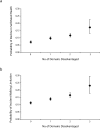Material resources and population health: disadvantages in health care, housing, and food among adults over 50 years of age
- PMID: 19890175
- PMCID: PMC2774171
- DOI: 10.2105/AJPH.2009.161877
Material resources and population health: disadvantages in health care, housing, and food among adults over 50 years of age
Abstract
Objectives: We examined associations between material resources and late-life declines in health.
Methods: We used logistic regression to estimate the odds of declines in self-rated health and incident walking limitations associated with material disadvantages in a prospective panel representative of US adults aged 51 years and older (N = 15,441).
Results: Disadvantages in health care (odds ratio [OR] = 1.39; 95% confidence interval [CI] = 1.23, 1.58), food (OR = 1.69; 95% CI = 1.29, 2.22), and housing (OR = 1.20; 95% CI = 1.07, 1.35) were independently associated with declines in self-rated health, whereas only health care (OR = 1.43; 95% CI = 1.29, 1.58) and food (OR = 1.64; 95% CI = 1.31, 2.05) disadvantage predicted incident walking limitations. Participants experiencing multiple material disadvantages were particularly susceptible to worsening health and functional decline. These effects were sustained after we controlled for numerous covariates, including baseline health status and comorbidities. The relations between health declines and non-Hispanic Black race/ethnicity, poverty, marital status, and education were attenuated or eliminated after we controlled for material disadvantage.
Conclusions: Material disadvantages, which are highly policy relevant, appear related to health in ways not captured by education and poverty. Policies to improve health should address a range of basic human needs, rather than health care alone.
Figures

References
-
- Adler NE, Ostrove JM. Socioeconomic status and health: what we know and what we don't. Ann N Y Acad Sci. 1999;896:3–15 - PubMed
-
- Braveman P, Egerter S. Overcoming Obstacles to Health: Report from the Robert Wood Johnson Foundation to the Commission to Build a Healthier America. Princeton, NJ: Robert Wood Johnson Foundation; 2008
-
- Smedley BD, Stith AY, Nelson AR. Unequal Treatment: Confronting Racial and Ethnic Disparities in Health Care. Washington, DC: The National Academies Press; 2003 - PubMed
-
- Berkman CS, Gurland BJ. The relationship among income, other socioeconomic indicators, and functional level in older persons. J Aging Health. 1998;10:81–98 - PubMed
Publication types
MeSH terms
Grants and funding
LinkOut - more resources
Full Text Sources
Medical

